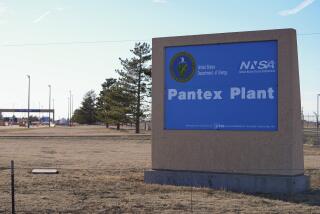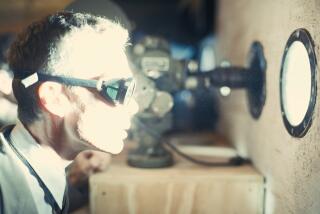Nuclear Cargo Seen Risky for Shuttle Flights
The fiery explosion that ripped apart the space shuttle Challenger 50,000 feet above the Florida coast has raised questions about the vulnerability of nuclear cargoes intended for future shuttle flights.
In fact, the next mission of the ill-fated Challenger was scheduled to carry the nuclear-powered Ulysses solar probe satellite into orbit late in May. The Ulysses and its Jupiter-probe cousin Galileo, which was also scheduled for launch this spring, are each fueled by nearly 50 pounds of plutonium-238.
Scientists say radioactive plutonium particles scattered as smoke or dust debris would pose a serious public health hazard to anyone who inhaled the cancer-causing residue. A cloud of plutonium particles released in the sky over Cape Canaveral could “turn parts of Florida into an area that’s uninhabitable,” Dr. John Gofman, professor of medical physics at UC Berkeley, said.
The Energy Department contends that the protective shell around the plutonium would withstand explosive pressures up to 2,200 pounds per square inch. However, a NASA safety analysis said that a wide range of possible shuttle accidents could generate greater force.
Deadly Cloud Unlikely
Dan Butler, an Energy Department spokesman, said Wednesday that “it appears” Challenger’s explosion would not have been sufficient to create a deadly plutonium cloud. The nuclear generators, he said, are wrapped first in iridium and then encapsulated in a graphite shell, a shield he characterized as unlikely to burn or shatter in a similar blast.
“The (shuttle) explosion appears to be less than 2,200-psi, and therefore not sufficient to rupture the capsule,” he said.
National Aeronautics and Space Administration officials declined comment on the force of the blast pending completion of their investigation.
The NASA-produced safety analysis report on the Galileo and Ulysses projects determined that a blast caused by activating the spacecraft’s “command destruct” mechanisms--explosive devices attached to the large external tank and suspected of being detonated by Challenger’s leaking solid rocket booster--would produce a burst of pressure ranging from 740-psi to 7,800-psi.
If a shuttle fails to get off the ground and topples over at the launch pad, even greater explosive pressure could be generated, according to the same NASA analysis. While the report says the expected pressure would range from 310-psi to 2,050-psi, a maximum range of pressure could be as high as from 2,000-psi to 19,600-psi.
Risk ‘Should Be Small’
In a draft environmental impact statement for Project Galileo, NASA and Jet Propulsion Laboratory officials reported that the risk of plutonium dispersal “should be small due to the high reliability inherent in the design of the space shuttle and the (plutonium capsule) design for containment.”
The report described as “highly improbable” accidents occurring during the shuttle launch and ascent, and it rated chances of human injuries from plutonium dispersal, even in the event of an accident during that period, at 10,000 to one.
Gofman, at UC Berkeley, said he is “not reassured.”
“What happened last week didn’t happen the way (officials) said it should,” Gofman said. “I don’t honestly know if plutonium could be dispersed by such an explosion, but for something as hazardous as plutonium, I’d want more assurances of safety.”
Gofman said he supports the NASA space program, but he expressed shock when told the Galileo and Ulysses projects would carry 50 pounds of plutonium, an amount he called “astronomical.”
He said it poses an environmental threat only if it can be inhaled, however. “If it comes back to Earth the size of marbles, that’s no problem; but you can kiss off any area that gets dusted.”
Concern Echoed
Dr. Henry Kendall, chairman of the Union of Concerned Scientists in Cambridge, Mass., echoed Gofman’s concern about plutonium danger. However, he expressed confidence in NASA’s ability to protect the plutonium.
“My guess is that the packaging is pretty good,” Kendall said. “If it just fell in a big chunk, it could be retrieved. It might upset people, but it would not, in any sense, produce a holocaust.”
NASA and Jet Propulsion Laboratory officials meeting this week in Florida reportedly are reassessing the risk as they explore ways to salvage at least one of the plutonium-fueled projects. Allen Wolfe, deputy Galileo project manager at the laboratory in Pasadena, said, “There’s a possibility it could go on the shelf.” However, he called that prospect “extremely low.”
“There’s enough sensitivity (over) any nuclear materials that we have to be extremely careful,” Wolfe said. He expressed confidence in the plutonium protective capsule, noting that it is supposed to withstand the intense heat and pressure of re-entering the Earth’s atmosphere.
Approval Needed
Presidential approval will have to be obtained, however, before the nuclear cargo can be launched aboard the shuttle Atlantis, the only surviving vehicle in the shuttle fleet that is capable of transporting the two large satellites and their Centaur rocket launchers.
Galileo and Ulysses would not be the first nuclear-equipped satellites launched by the United States. According to NASA, 22 payloads--including some aboard the manned Apollo lunar probes and the Voyager satellites--incorporated plutonium-fueled generators.
Three launches resulted in aborts. In 1964, the plutonium generator aboard a navigational satellite burned up on re-entry. According to Gofman, traces of plutonium were scattered around the globe from that incident, leaving “trivial amounts” in virtually all living things.
In 1968 a meteorological satellite was destroyed when the launch vehicle veered off course and its plutonium was recovered from the ocean intact, according to NASA. And in 1970 the Apollo 13 mission, curtailed by an explosion in flight, jettisoned its plutonium generator prior to re-entry, depositing it in the South Pacific’s Tonga Trench where, according to NASA, “it is effectively isolated from man’s environment.”
Staff Writer Lee Dye contributed to this article.
More to Read
Sign up for Essential California
The most important California stories and recommendations in your inbox every morning.
You may occasionally receive promotional content from the Los Angeles Times.










